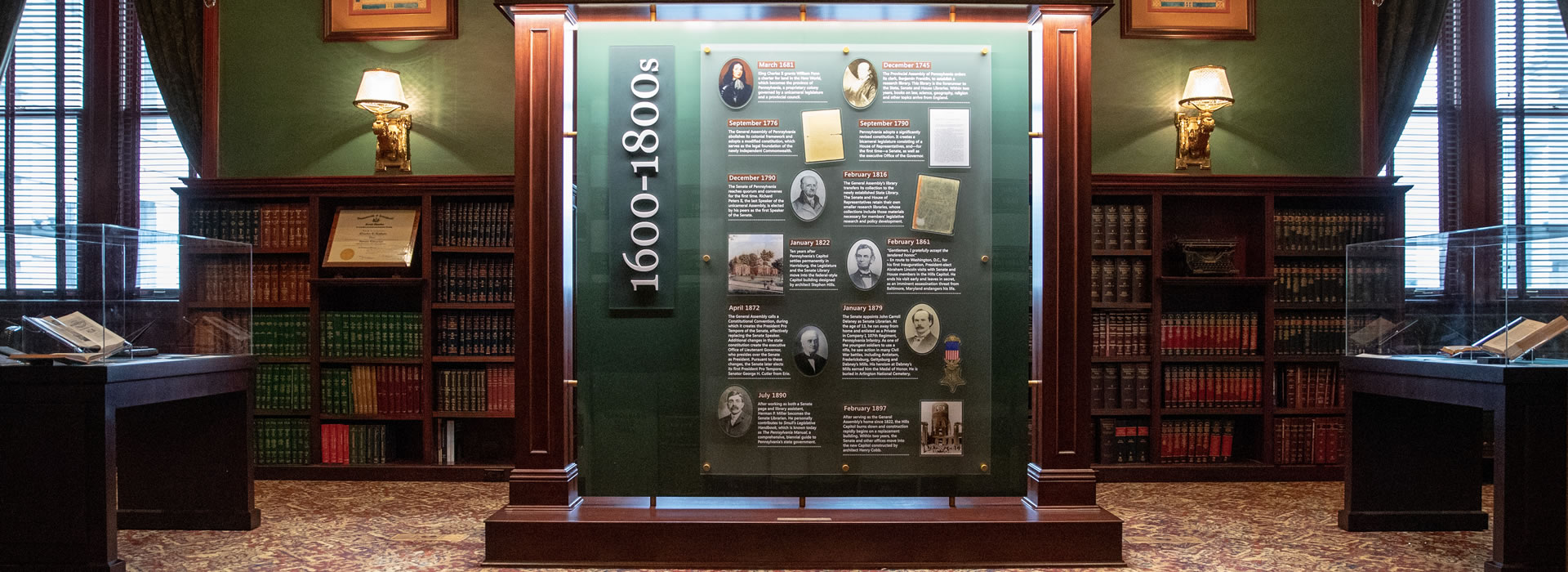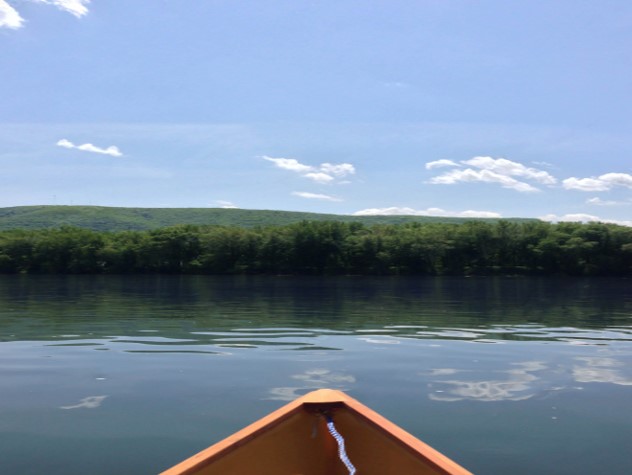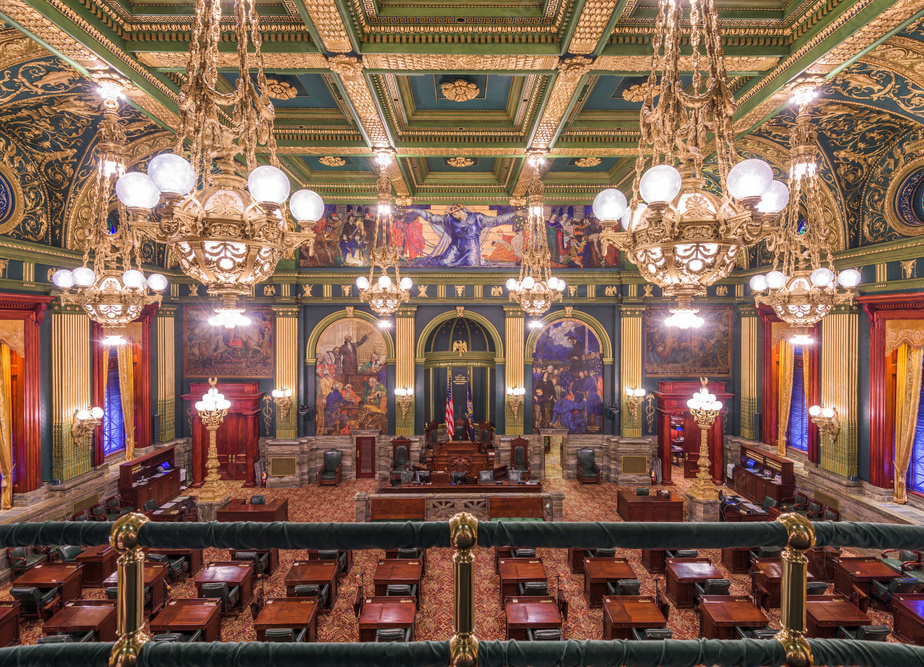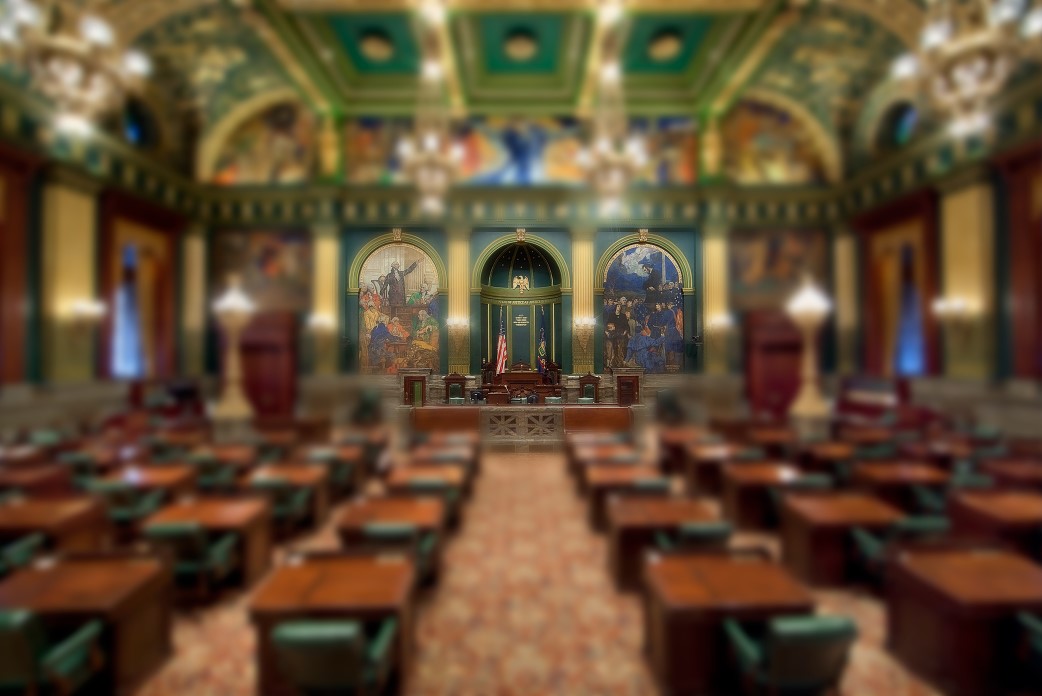Flowing Perspectives
Flowing Perspectives
Flowing Perspectives focuses on the historic role state government plays in keeping Pennsylvania’s watersheds safe. As part of the Chesapeake Bay’s watershed, the Susquehanna River contributes more than fifty percent of freshwater, nutrients, and sediment into the country’s largest estuary. From acid mine drainage to poor sanitary conditions, key figures like Mira Lloyd Dock and, former Senators Franklin Kury and Noah Wenger were instrumental in cleaning up the Commonwealth’s waters. Their actions along with state government initiatives like the Chesapeake Bay Commission and the Department of Environmental Protection not only enhanced the lives of Pennsylvanians but also help protect Maryland’s seafood industry and promote the overall well-being of the Chesapeake Bay.
The Susquehanna River begins its southernly journey through Pennsylvania to Maryland from a small stream in Otsego Lake, New York. Spanning 444 miles, the Susquehanna is the longest river on the East Coast of the United States. In Pennsylvania, the river becomes a vital resource of the Susquehanna Valley. Native Americans and early European settlers established communities along the riverbanks, contributing to the region's growth. During the American Revolution, Pennsylvania’s watersheds played a vital role, serving as a transportation route for troops and supplies. The construction of the Susquehanna and Tidewater Canal in the 19th century further cemented its importance in facilitating trade and commerce. However, the rise of manufacturing and mining released pollutants into rivers, affecting aquatic ecosystems. The combination of industrial discharge and poor sanitation had lasting consequences on Pennsylvania's watersheds, necessitating awareness and conservation efforts in subsequent years.
Harrisburg native, Mira Lloyd Dock played a pivotal role in the restoration and preservation of the Susquehanna River in the late 19th and early 20th centuries. Her tireless efforts resulted in major changes in how the Commonwealth treated its watersheds. Recognizing the urgent need for intervention, Dock became a driving force in the “City Beautiful” movement which took aim at reforming unsanitary cities across America.
Senator Kury recognized the urgent need to address water pollution in Pennsylvania. Multiple fish deaths from water pollution discourage people from using the waterways. As a candidate for the State House in 1966, he ran on a platform “For Clean Streams and Clean Politics.” Kury worked tirelessly to gain bipartisan support for his groundbreaking legislation aimed at protecting and revitalizing the state's watershed.
At the State Capitol, Senator Noah Wenger fought for farmers throughout the state. Wenger also recognized the impact that farming had on the Susquehanna River and the health of the Chesapeake Bay. Wenger became a member of the Chesapeake Bay Commission in 1985 and later served as chairman. Known for finding common ground between conservationist and agricultural interest, Wenger was able to establish several cleanup initiatives to improve the health of the Susquehanna River.
This exhibition highlights legislative efforts that have shaped and protected Pennsylvania's water resources over the years. We hope visitors gain insight into some of the crucial decisions, policies, and initiatives that contributed to the preservation of the Commonwealth’s watersheds, so we can continue to enjoy serene kayaking trips and thrilling fishing adventures for generations to come.
- Senator Kury’s book: Clean Streams and Clean Politics: Senate Library of Pennsylvania
- Book Down the Susquehanna to the Chesapeake: Senate Library of Pennsylvania
- Photos of Senator Tilghman and members of the Chesapeake Bay Commission: Pennsylvania House of Representatives House Archives
- 1987 Chesapeake Bay signed Agreement: Pennsylvania House of Representatives House Archives
- Photograph of Jimmy Carter: Pennsylvania State Archives
- Fishing Photographs: Pennsylvania State Archives
- Photos from Fish and Boat Commission: Pennsylvania State Archives
- Photo of the first steamboat of Millersburg Ferry: Pennsylvania State Archives
- Fishing Rod and reel, tackle box, fish plaque, homemade fly-fishing lures: Pennsylvania State Museum
- Photos of Harris Crab House and oyster boat: Harris Crab House
- Picture of Chesapeake Watermen hand tonging for oysters on workboat: Sea Grant Maryland mdsg.umd.edu
- Picture of man hand tonging for oysters: Chesapeake Bay Maritime Museum
Goals
- The viewer will be able to identify Members of the Pennsylvania Senate who actively served as well as were involved in major military conflicts throughout the history of our country.
- The viewer will recognize that Members of the Pennsylvania Senate came to the legislature with their own unique perspectives, often based on their military service/careers.
- The viewer will understand that Members of the Pennsylvania Senate have gone beyond the call of duty, as evidenced by their distinguished careers during their military service.
- The viewer will be exposed to the major conflicts involving the United States of America, from the 1860s until the present day. (Specifically, American Civil War, World War I, World War II, Korean War, Vietnam War, Iraq War, and Global War on Terrorism).
Pennsylvania Academic Standards
(History, US History, and Civics and Government) met in whole or in part* by this exhibition
Standard - 5.1.6.A: Explain the effect of the rule of law in protecting property rights, individual rights, and the common good.
The entire exhibition fulfills this standard by allowing the viewer to observe how Pennsylvania’s General Assembly created legislation to protect the state’s water resources.
Standard - 5.2.6.A: Compare and contrast rights and responsibilities of citizenship in the community, state, and nation.
The entire exhibition fulfills this standard by allowing the viewer to observe Pennsylvania citizens enjoying water recreational activities that were made possible by legislation.
Standard - 5.2.6.B: Explain how citizens resolve conflicts in society and government.
The entire exhibition allows the viewer the opportunity to fulfill this standard through an examination of the various sources on display which shows how citizens reacted to situations that effected their livelihood.
Standard - 5.3.6.C: Describe how local, state, and national governments provide services.
The entire exhibition allows the viewer the opportunity to fulfill this standard through learning what the Pennsylvania Department of Environmental Protection, the Chesapeake Bay Commission, and other organizations does to safeguard the state’s water resources.
Standard - 5.3.6.D: Identify leadership positions and their primary duties at the local, state, and national levels.
The entire exhibition fulfills this standard by featuring state Senators who chairs the state Fish and Game Committee and the Chesapeake Bay Commission.
Standard - 5.3.6.G: Identify individual interest groups and how they impact government.
The entire exhibition fulfills this standard by allowing the viewer to observe how important the watershed is to the state and how legislators advocate for them.
Standard - 7.1.6.B: Describe and locate places and regions as defined by physical and human features.
A section of this exhibition allows the viewer the opportunity to fulfill this standard through an examination of photos and other secondary sources that explains difference areas of the Susquehanna River from New York to Maryland’s Chesapeake Bay.
Standard - 7.4.6.B: Describe and explain the effects of people on the physical systems within regions.
The entire exhibition allows the viewer the opportunity to fulfill this standard through an examination of materials that shows how water conservation efforts started due to the industrial revolution.
Exhibition Team
- Michael Gerdes, Secretary and Parliamentarian of the Senate
- Alexandra Acri Barbush, Librarian of the Senate
- Martavis Washington, Research & Exhibit Specialist
- Donna Wheeler, Record Services Manager, Senate Library
- George Soule, Research Services Manager, Senate Library
- Jess Rodic, Assistant Secretary of the Senate
- Ashley Haldeman, Executive Assistant, Office of the Secretary of the Senate
Democratic Caucus Operations Staff
- Kristin Markle, Graphics Designer/Illustrator
- Shannon Yordy, Multimedia Designer/Illustrator
- Ashlyn Williams, Multimedia Specialist
Republican Communications Staff
- Gary Brunner, Director of Graphic Arts
Senate Print Shop/Digital Production
- Chris Keller, Director
- Caleb Gordon, Deputy Director
- Leah LaPerle, Prepress Operator
Other Organization and Individuals
- Legislative Data Processing Center
- Pennsylvania House of Representatives House Archives
- Ty Stump, Archivist, Pennsylvania State Archives
- Anne Marie Ickes, Archivist/PHMC Records Coordinator, Pennsylvania State Archives
- Robert D. Hill, Military & Industrial History Curator, State Musuem of Pennsylvania
- Katelyn Metz, Curator, State Museum of Pennsylvania




.jpg)

